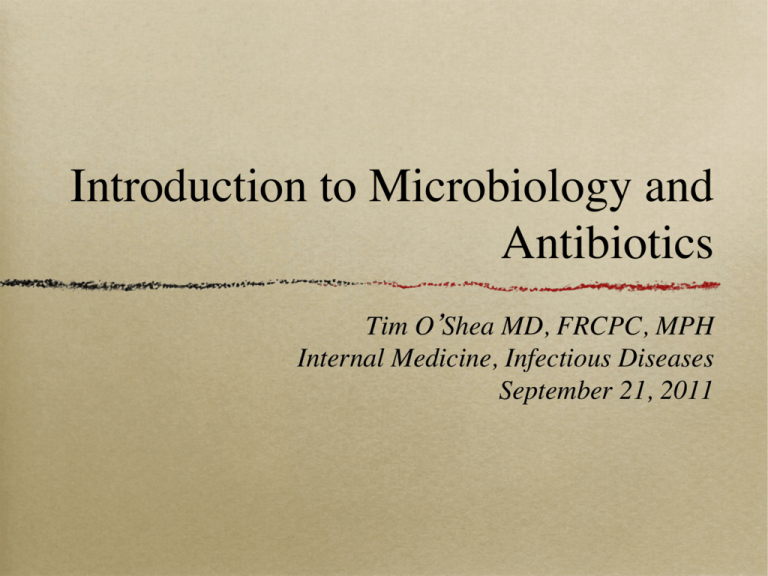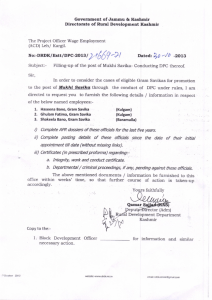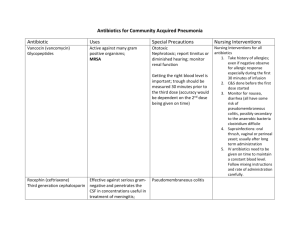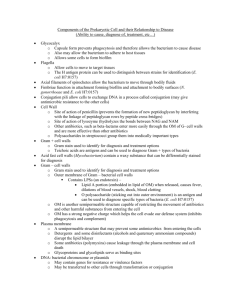Introduction to Microbiology and Antibiotics
advertisement

Introduction to Microbiology and Antibiotics Tim O Shea MD, FRCPC, MPH Internal Medicine, Infectious Diseases September 21, 2011 Outline ! ! What do I need to know about microbiology to: ! Pass the POS ! Be a safe and efficient clinician What do I need to know about antibiotics to: ! Pass the POS ! Be a Safe and efficient clinician Introduction to Microbiology Micro-organisms Bacteria Virus Fungi Parasite Bacteriology Bacteria Gram Positive Gram Negative Other Gram Stain Cellular Morphology Pop Quiz • You are on call for the orthopedic surgery service at the JHCC. You get called at 2 am by a nurse on F5 with a positive blood culture result, gram positive cocci. • What are the possible organisms? • How do you decide if you need to treat? • What do you treat with? Gram Positive Cocci Catalase Staphylococcus Coagulase Streptococcus Enterococcus Strep. pneumo Viridan’s group strep Lancefield groupable strep S. aureus CNSt Glycopeptides • • • • The glycopeptide available to you is vancomycin Also teicoplanin, televancin, bleomycin, dalvabancin Bind to the cell wall to prevent peptidoglycan synthesis Bacterostatic (except against enterococci) Glycopeptides • Toxicities – • Renal – probably overstated • Hypotension/red man syndrome • • Hematologic – eosinophilia, thrombocytopenia Monitoring – only in patients with blood stream/bone infections, renal disease/ changing renal function, large BMI Beta-lactams Beta-lactam Antiboitcs • • Includes: • Penicillins • Cephalosporins • Cephamycin • Carbapenems • Monobactams Generally regarded as bacteriocidal Beta-lactam Antibiotics • Adverse reactions: • Allergy – IgE mediated • Other rash • Neurologic • Renal • Gastrointestinal • Pulmonary • Hematologic Penicillins Penicillins Pen G Antistaphylococcal Broad Spectrum Amp/ amox Cloxacillin Ticarcillin Pip Pen G • Active against: • • • • • Gram positive cocci (exception – penicillinase producing Staphylococci, penicillin resistant pneumococci, enterococci, MRSA) Gram positive bacilli Gram negative cocci (exception penicillinase producing Nisseria gonnorhea) Most anaerobes (exception Bacteroides) For susceptible GPC there is NO BETTER ANTIBIOTIC CHOICE Anti-staphylococcal Penicillins • • • Active against penicillinase producing strains of S. aureus, but not against MRSA For susceptible strains of S. aureus these antibiotics are ALWAYS the drug of choice Use limited by side effects and toxicities, less active then pen G against nonpenicillinase producers; not active against GPB or GNC Broad Spectrum Penicillins • • • • • Distinguished by activity against GNB None are active against penicillinase producing S. aureus 2nd generation (amox/amp) – active against most strains of E. coli, P. mirabilis, Salmonella, Shigella, H. flu 3rd generation (carbenicillin) – more stable to chromosomal beta lactamases, useful in Pseudomonal infections 4th generation (Piperacillin) – similar to 3rd generation, more active against Pseudomonas Penicillins • • • All have relatively short half-lives and achieve good levels in pericardium, pleural fluid, urine, peritoneal and synovial cavities All achieve higher levels in bile than serum, especially true for amp and piperacillin Dose adjustments in renal dysfunction in all but clox Cephalosporins Cephalosporins 1st generation (Cefazolin/ Cephelexin) 2nd generation 4th generation 3rd generation No pseudomonas (Ceftriaxone) Activity against H. flu (cefuroxime) Activity against Bacteroides (cefoxitin) Antipsuedomonal (Ceftaz) Cephalosporins • First generation (Cephelexin, Cefazolin): • • • • Active against most GPC (not MRSA, penicillin resistant pneumococcus, enterococci) Active against most E. coli, P. mirabilis, K. pneumoniae Not active against SPICE organisms, non-fermenters, H. flu (generally) Active against many anaerobes, not Bacteroides Cephalosporins • 2nd generation (Cefuroxime) • • • Less active against GPC, enhanced activity against some gram negatives Highly active against H. flu and betalactamase producing M. catarrhalis Cefamycins (cefoxitin, cefotetan) • • Good activity against Enterobacteraciae (not SPICE) and against anaerobes including Bacteroides (variable resistance) Useful for interabdominal infections Cephalosporins • 3rd generation: • • Poor pseudomonal coverage (Cefotaxime, Ceftriaxone, Cefipime) – excellent gram negative coverage (not SPICE), no activity against Acinitobacter or Pseudomonas, less effective than first generation ceph against GPC Anti-pseudomonal group (Cefoparazone, Ceftaxadime) – similar gram negative coverage with addition of Pseudomonas; poor activity against GP organisms Cephalosporins • 4th generation (Cefepime) • • Excellent gram negative coverage (equivalent to 3rd generation), pseudomonas coverage equivalent to Ceftaz, active against SPICE organisms, 5th generation (Ceftobiprole) • Broad spectrum – active against MRSA, enterococci, penicillin resistant S. pneumo, gram negatives Pop quiz # 2 • • Another night on call, this time on urology rotation at St Joes Called from ward with regards to post-op patient with positive blood culture – gram negative bacilli • What are the possible bugs? • What will help you decide if you need to treat? • What antibiotics will you use? Gram Negative Bacilli Fluoroquinolones • • • • Direct inhibitors of DNA gyrase and topoisomerase IV (bactericidal) Excellent gram negative coverage (enterobacteraciae, pseudomonas, GNC) Respiratory fluoroquinolones have added coverage against GPC and agents of atypical pneumonia Moxifloxacin has enhanced anaerobic coverage Aminoglycosides • • Bind to ribosomal RNA to inhibit protein synthesis Main uses include treatment of serious infections due to gram negative bacilli and synergistic treatment of some staphylococcal and enterococcal infections Aminoglycosides • • Once daily dosing is sufficient (preferred) for all but a few indications Toxicity: • Renal • Ototoxicity • Neuromuscular blockade (myasthenia gravis) Pop Quiz #3 • Several months later you are on call as the in-house junior on your ICU-E rotation at the HGH. You are called at 2 am regarding a patient post-op day 1 after laparotomy for penetrating trauma. The patient has become suddenly hypotensive, tachycardic and has a fever of 39.5 Celsius Pop quiz 3 • • • What are the potential organisms What factors will lead you to treat empirically What antibiotics THE BIG GUNS Piperacilin - Tazobactam • • Broad spectrum antibiotic with excellent gram positive, gram negative, anaerobic coverage Does not: • Reliably cover SPICE organisms • Cover MRSA • Cover amp-resistant Enterococcus • Cover (generally) pip resistant strains of Pseudomonas CARBAPENEMS • • • Generally stable to most beta-lactamase enzymes Excellent gram positive, gram negative, anaerobic coverage DOES NOT cover • • Burkholderia, Stenotrophomonas, Enterococcus feacium, MRSA Ertapenem does not cover pseudomonas AMOX/CLAV • • • Similar spectrum of activity to pip/taz, no pseudomonas coverage Available as oral preparation Main side effect is gastrointestinal upset/ diarrhea MOXIFLOXACIN • • • Available as po or IV Similar coverage to levofloxacin with enhanced anaerobic coverage No MRSA, rapid resistance develops with S. aureus, not reliable for serious enterococcal infections The Big Guns - Principles • • • • Try to tailor antibiotic choice to clinical presentation When source of infection is unclear and patient is seriously ill, cover broadly ALWAYS reassess antibiotics in patients on broad spectrum agents at least daily; narrow spectrum if source becomes clear Become familiar with what is being missed, if patient not improving, broaden (or stop?) Questions?







